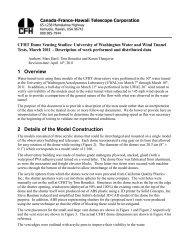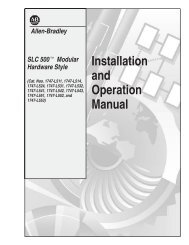Documentation [PDF] - Canada France Hawaii Telescope ...
Documentation [PDF] - Canada France Hawaii Telescope ...
Documentation [PDF] - Canada France Hawaii Telescope ...
You also want an ePaper? Increase the reach of your titles
YUMPU automatically turns print PDFs into web optimized ePapers that Google loves.
4.4.6 Stellar color-color plots<br />
The nearly blackbody emission spectra of stars places them in a narrow line in optical and infrared colorcolor<br />
space. Under the assumption that stellar loci in the ugriz color space are intrinsically universal, one<br />
can identify this locus and use it to calibrate the colors (and magnitudes) of the CFHTLS sources. As in<br />
previous releases, a comparison between the CFHTLS point-source colors and stellar model tracks have<br />
been used in order to assess the stability of survey photometry from tile to tile and across the whole Wide<br />
area.<br />
The stellar color-color loci are derived from a sample of well-defined bright stars selected from the<br />
T0007 merged catalogues. Only unsaturated objects with 17 < i < 21 and located in unmasked regions<br />
are considered (i.e. objects with FLAG==1. The MAG_AUTO as well as as the MAG_IQ20 magnitudes<br />
of the sources are plotted in the (u ∗ −g)/(g − r), (g − r)/(r − i) and (r − i)/(i − z) color-color diagrams<br />
with the color tracks of the stellar models (Pickles, 1998).<br />
We wish to remind the reader that the Pickles stellar library is not complete in the (T e f f ,log g) stellar<br />
parameter space, especially in the log g range. In addition, the stellar library covers only stars with solar<br />
metallicity. As shown in Schultheis et al. (2006), the CFHTLS fields are a mixture of different stellar<br />
populations with different metallicities, i.e. the thin disc, the thick disc and the halo population. The<br />
effects of metallicity is largest in the (u − g) color and therefore systematic offsets compared to Pickles<br />
are to be expected. Sesar et al. (2011) studied the metallicities of the CFHTLS Wide fields and they<br />
found clearly a mean metallicity below solar ([Fe/H]=-1.5). However, the metallicity variation over the<br />
Wide fields has yet to be determined.<br />
To illustrate the effect of metallicity, Figure 38 shows the Basel 3.1 model track (Westera et al., 2002)<br />
with [Fe/H]=-1.0 (i.e. low metallically) in comparison to the Pickles models (bottom panels) with solar<br />
metallicity. While we see clearly an offset in (u − g) and (g − r) from the Pickles stars, this offset<br />
completely disappears using the Basel 3.1 [Fe/H]=-1.0 track. We therefore conclude that these offsets<br />
seen with respect to the Pickles stars do not represent a photometric calibration problem and can instead<br />
be explained from metallicity variations. Furthermore, realistic models of the galaxy indicate that the<br />
variations in metallicity expected in fields of sizes comparable to the CFHTLS Wide patches could<br />
correspond to displacements in color-color space of a few percent or larger,<br />
4.4.7 Color offsets between CFHTLS and SDSS<br />
In the previous CFHTLS release (T0006), the stellar locus in the Wide tiles has been used to recalibrate<br />
the photometry and improve the final field to field scatter. The differences between the loci of CFHTLS<br />
and SDSS stars in color-color tracks can be used to determine the color offsets, ∆ S m−m LR between the two<br />
′<br />
surveys. However, as we have seen in the previous sections, the expected percent-level photometric precision<br />
of the CFHTLS Wide survey now exceeds the metallicity-induced field-to-field variations in color<br />
which we would expect in a survey the size of the CFHTLS. Consequently, this raises doubts concerning<br />
the ability of the “Stellar Locus Regression” (SLR) fitting techniques to enable further reductions in the<br />
photometric scatter of the CFHTLS wide.<br />
To test this, we checked the potential improvement on the color offsets compared to SDSS using the SLR<br />
recalibration. First, we computed the color offsets with respect to the SDSS reference catalog δ m−m ′.<br />
We then computed the correcting color offsets from the SLR method as described in the T0006 documentation<br />
∆ SLR m−m ′ . We finally compared the rms of the color offsets across the Wide patch compared<br />
to SDSS before and after the application of the SLR corrections. Before re-calibration, the scatter in<br />
(u − g), (g − r), (r − i) and (i − z) with respect to the transformed SDSS stellar locus is 0.011, 0.005, 0.008<br />
57


![Documentation [PDF] - Canada France Hawaii Telescope ...](https://img.yumpu.com/26965302/69/500x640/documentation-pdf-canada-france-hawaii-telescope-.jpg)









